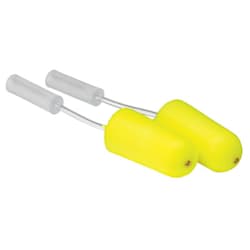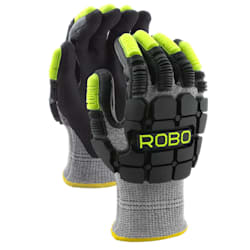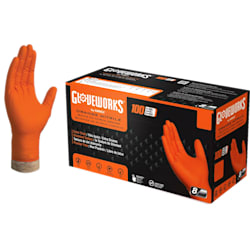Disposable Gloves Guide
Guide to Buying Disposable Gloves | Nitrile, Latex, Vinyl
View our guide to find out the difference between nitrile, latex, and vinyl disposable gloves, how they are made, and what you should consider when buying them.
What's the Difference Between Nitrile, Latex, and Vinyl Disposable Gloves?
Nitrile Disposable Gloves
Nitrile gloves are the main alternative to latex disposable gloves. While they are less flexible than latex gloves, their durability and chemical resistance outweigh their rigidity. Nitrile disposable gloves are optimal for those handling hazardous or potentially corrosive chemicals that cannot be withstood by vinyl or latex. With their higher puncture resistance and lack of latex, nitrile disposable gloves are ideal for medical environments especially those where latex allergies are a concern.
Latex Disposable Gloves
Latex (natural rubber) gloves are useful with biological and water-based materials. However, they provide poor protection against organic solvents and offer little chemical resistance. They can also trigger latex allergies. For those who aren't allergic, latex disposable gloves are comfortable, low cost, and have high touch sensitivity. These characteristics make them suitable for most medical environments where latex allergies are not a concern.
Vinyl Disposable Gloves
The main advantage to vinyl gloves is their low manufacturing cost. Vinyl gloves also avoid the risk of latex allergies. Vinyl disposable gloves are ideal for quick single-use tasks that require easy donning and removal in busy food service, medical, or industrial settings (non-hazardous and low-infection environments). They are less durable and offer less protection than nitrile or latex gloves as any stretching can reduce their molecular integrity.
What to Consider When Buying Disposable Gloves
Disposable Gloves Thickness & Length
3 mil - 8 mil is the most common range of glove thicknesses
- Medical grade gloves have lower thicknesses and a corresponding increased dexterity
- Thicker gloves (4 - 5 mil) are more suited to industrial environments
- 8 mil+ gloves are ideal when you need extra protection from corrosive chemicals or other hazardous evironments.
- Longer gloves also provide additional protection such as disposable nitrile gloves with 12" extended cuffs
Disposable Glove Color
Disposable glove color is generally preferential based on the industry and application
- Black disposable gloves are used in industrial applications to hide dirt or blood (think tattoo artist).
- Varying colors are used to differentiate between departments in food processing. This can prevent cross-contamination and if a foreign material is found in the product, it can be traced back to the source
- Disposable gloves in medical applications are most often blue or indigo
Powdered vs. Powder-Free
Disposable Gloves
- Powdered disposable gloves have cornstarch added to make donning and removal easier, especially in busier environments. Powdered gloves have raised concerns about exacerbating latex allergies or sticking to hands, surfaces, or clothing after use.
- Powder Free disposable gloves go through a process called chlorination, making them less form-fitting and easier to don and remove. This process can reduce grip and make them harder to remove quickly.
Disposable Glove Grade & Standards
Glove Grade is determined by measuring the Acceptance Quality Limit or AQL. AQL measures the percentage likelihood of pinhole defects in a batch of disposable gloves. A predetermined number of gloves from a batch are selected and tested for water tightness - or leakage. The AQL rating represents the percentage of gloves per hundred that leaked in a batch of disposable gloves.
Example:
- Disposable gloves rated with a 1.5 AQL have 1.5 defects per 100 gloves
- Surgical gloves require an 0.65 AQL or lower
- Medical Gloves & Exam require a 1.5 AQL or lower
- Industrial-grade gloves require a 4.0 AQL or lower
What's the difference between medical and exam-grade disposable gloves?
- They are the same. Medical exam grade gloves can be referenced three ways - Exam, Medical, or Medical Exam Grade. All three labels are correct and equal. To use this label, gloves must be manufactured with a 1.5 AQL or lower at an FDA-authorized 510(k) facility.
What is a 510(k) for exam-grade disposable gloves?
- A 510(k) is a document approved by the FDA that allows medical devices to be introduced into commercial distribution.
- Exam/Medical grade gloves are regulated by the FDA as Class I reserved medical devices that require a 510(k) premarket notification.FDA - Medical Gloves 510(k)
How can I tell if a glove is rated for food contact?
- Food service gloves or food prep gloves are certified under FDA Title 21 CFR Part 177, stating that the material components of the glove comply with the FDA regulations and the gloves consist of “Substances generally recognized as safe for use in food or food packaging.”
How can I tell if a disposable glove is rated for use with chemotherapy?
- If a glove is rated safe for use during chemotherapy that means it has been determined as compliant under USP 800 and ASTM D6978-0
- These are standards for handling hazardous drugs to minimize the risk to the personnel handling them.
- Gloves are approved by testing them for permeation against the various hazardous drugs used during chemotherapy.
How can I tell if a disposable glove is rated for cleanroom use?
- Cleanroom gloves are rated for use using the ISO 14644-1:2015 classification system. This system creates classes of “clean” based on measured airborne particulates per cubic meter - numbered ISO 9 down to ISO 1 (cleanest).
- Gloves specifically designed for these special applications are carefully laundered, tested, and packed/labeled by the manufacturer to ensure a particle count that is compatible with the cleanroom environment where they will be used.
How Are Disposable Gloves Made?
Nitrile and vinyl gloves are not made from natural rubber like latex gloves. These disposable gloves come from synthetic materials, but the process of manufacturing them is similar for all three.
Once the synthetic materials for nitrile and vinyl gloves are prepared, they go through nearly the same production process as latex gloves:
- Ceramic formers shaped like hands are cleaned with water and bleach, removing and residue. Once the formers are dry, they are dipped in a calcium nitrate/calcium carbonate mixture to help the material coagulate. The formers are then left to dry again.
- The formers are then dipped into tanks of NBR or PVC, then heated at a high temperature to form the gloves as they dry.
Nitrile disposable gloves go through one of two processes to help them apply to the hand more easily:
- Chlorination: Chlorince as an acid or gas is applied to the gloves to harden the material and make it slicker.
- Polymer coating: A layer of polymer is added to lubricate the glove surface.
In the stripping phase, blasts of air remove the gloves from the formers. Finally, the gloves are tested, packaged, and shipped.
.jpg?width=1600&height=180)












